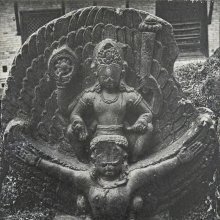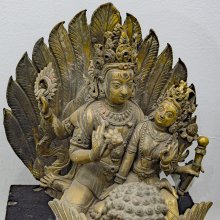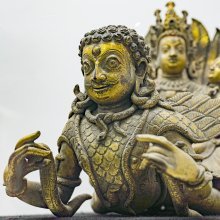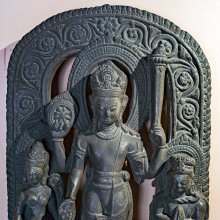Garudasana, Garuda-asana, Garuḍāsana: 7 definitions
Introduction:
Garudasana means something in Buddhism, Pali, Hinduism, Sanskrit. If you want to know the exact meaning, history, etymology or English translation of this term then check out the descriptions on this page. Add your comment or reference to a book if you want to contribute to this summary article.
Images (photo gallery)
In Hinduism
Yoga (school of philosophy)
Source: Wisdom Library: YogaGaruḍāsana (गरुडासन, “Garuḍa posture”) is a Sanskrit word referring to a type of posture (āsana) used in Yoga. It is composed of the words Garuḍa (bird, mount of Viṣṇu) and āsana (posture).
Source: archive.org: Yoga Tradition of the Mysore PalaceGaruḍāsana (गरुडासन) is a type of posture (āsana), according to verse 39 of the Śrītattvanidhi.—Accordingly, “Place the ankle of the other foot at the base of the thigh and the same knee on the heel. Bring the hands together. This is garuḍāsana, the eagle”.
The 19th-century Śrītattvanidhi is a sanskrit treatise describing 80 primary āsanas, or ‘posture’ (e.g., garuḍa-āsana) and several additional ones.
This name and a comparable form is found in Iyengar and in First Steps to Higher Yoga. The name is found in the Mallapurāṇa list. Gheraṇḍasaṃhitā II.37 uses this name but has an entirely different āsana shown.
Source: archive.org: Gheranda SamhitaGaruḍāsana (गरुडासन) is one of the thirty-two āsanas (postures) taught in the second chapter of the Gheraṇḍasaṃhitā: “Firmly fixing the legs and the thighs on the ground, keeping the body steady with the (help of the) two knees, place hands on the knees. This is called Garuḍāsana”.
Garuḍāsana is one of the selected 32 postures amongs 8,400,000 total mentioned by Śiva, according to Gheraṇḍasaṃhitā 2.1-2, “In all, there are as many Āsanas as species of animals. Eighty-four lacs of them are mentioned by Śiva. Out of them, 84 are regarded as important and among these 84, again 32 are good (enough) in this world of mortal beings”.
The 17th-century Gheraṇḍasaṃhitā (mentioning garuḍa-āsana) is one of the three classic texts of Haṭha-yoga: a major branch of Yoga, sharing similarities with the Yoga system taught by Patañjali, though claiming its own mythical founder known as Matsyendranātha. This gheraṇḍa-saṃhitā is an encyclopedic Sanskrit treatise describing thirty two such āsanas.

Yoga is originally considered a branch of Hindu philosophy (astika), but both ancient and modern Yoga combine the physical, mental and spiritual. Yoga teaches various physical techniques also known as āsanas (postures), used for various purposes (eg., meditation, contemplation, relaxation).
Shilpashastra (iconography)
Source: Shodhganga: The significance of the mūla-beras (śilpa)Garuḍāsana (गरुडासन) refers to a type of Āsana (sitting poses), according to Ganapati Sthapati in his text Ciṟpa Cennūl, as defined according to texts dealing with śilpa (arts and crafs), known as śilpaśāstras.—The right leg is folded inward with its knee supported on the ground; the left leg is bent and stretched away from the body with the foot resting on the ground. This posture is called garuḍāsana. Garuḍa, the vehicle of Śiva is found in this posture.

Shilpashastra (शिल्पशास्त्र, śilpaśāstra) represents the ancient Indian science (shastra) of creative arts (shilpa) such as sculpture, iconography and painting. Closely related to Vastushastra (architecture), they often share the same literature.
Purana and Itihasa (epic history)
Source: archive.org: Shiva Purana - English TranslationGaruḍāsana (गरुडासन) refers to “(being seated on) the Garuḍa-posture”, according to the Śivapurāṇa 2.3.40 (“The Marriage Procession of Śiva”).—Accordingly, as Brahmā narrated to Nārada: “[...] O sage, Viṣṇu, seated on Garuḍa (garuḍāsana) and going in the middle of the group shone with the great umbrella held aloft. He was surrounded by his attendants who fanned him with Cāmaras. His Pārṣadas too shone well. He was bedecked in all his ornaments. I too shone well on the way with the Vedas, Śāstras, Purāṇas and Āgamas personified and along with my sons, Prajāpatis, Sanaka and other Siddhas. I was eager in rendering service to Śiva. [...]”.

The Purana (पुराण, purāṇas) refers to Sanskrit literature preserving ancient India’s vast cultural history, including historical legends, religious ceremonies, various arts and sciences. The eighteen mahapuranas total over 400,000 shlokas (metrical couplets) and date to at least several centuries BCE.
In Buddhism
Tibetan Buddhism (Vajrayana or tantric Buddhism)
Source: OSU Press: Cakrasamvara SamadhiGaruḍāsana (गरुडासन) refers to “sitting on an eagle”, according to the Guru Mandala Worship (maṇḍalārcana) ritual often performed in combination with the Cakrasaṃvara Samādhi, which refers to the primary pūjā and sādhanā practice of Newah Mahāyāna-Vajrayāna Buddhists in Nepal.—Accordingly, “Vairocana Buddha in the middle, Akṣyobhya abiding eastward, Amitābha in the west, and Ratnasaṃbhava in the south, Also Amoghasiddhi in the north, the permanent five Tathāgata, White, dark blue (and) yellow, one of the reds, (and) dark green, Going, sitting on a lion, elephant, horse, peacock, (and) an eagle (garuḍāsana), Five syllables arising together, Pañca Buddha, I give homage”.

Tibetan Buddhism includes schools such as Nyingma, Kadampa, Kagyu and Gelug. Their primary canon of literature is divided in two broad categories: The Kangyur, which consists of Buddha’s words, and the Tengyur, which includes commentaries from various sources. Esotericism and tantra techniques (vajrayāna) are collected indepently.
Languages of India and abroad
Kannada-English dictionary
Source: Alar: Kannada-English corpusGaruḍāsana (ಗರುಡಾಸನ):—[noun] the kneeling on one knee, one of the yogic postures.
Kannada is a Dravidian language (as opposed to the Indo-European language family) mainly spoken in the southwestern region of India.
See also (Relevant definitions)
Relevant text
Search found 1 books and stories containing Garudasana, Garuda-asana, Garuḍa-āsana, Garuḍāsana; (plurals include: Garudasanas, asanas, āsanas, Garuḍāsanas). You can also click to the full overview containing English textual excerpts. Below are direct links for the most relevant articles:
Bhagavati-sutra (Viyaha-pannatti) (by K. C. Lalwani)
Part 2 - Life of Mahābala < [Chapter 11]



